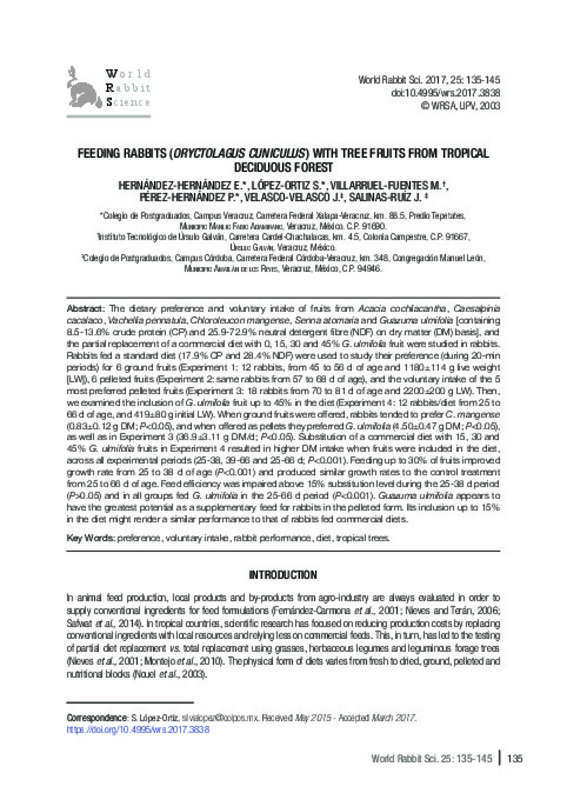JavaScript is disabled for your browser. Some features of this site may not work without it.
Buscar en RiuNet
Listar
Mi cuenta
Estadísticas
Ayuda RiuNet
Admin. UPV
Feeding rabbits (Oryctolagus cuniculus ) with tree fruits from tropical deciduous forest
Mostrar el registro sencillo del ítem
Ficheros en el ítem
| dc.contributor.author | Hernández-Hernández, Eliceo
|
es_ES |
| dc.contributor.author | López-Ortiz, Silvia
|
es_ES |
| dc.contributor.author | Villarruel-Fuentes, Manuel
|
es_ES |
| dc.contributor.author | Pérez-Hernández, Ponciano
|
es_ES |
| dc.contributor.author | Velasco-Velasco, Joel
|
es_ES |
| dc.contributor.author | Salinas-Ruíz, Josafhat
|
es_ES |
| dc.date.accessioned | 2017-07-10T09:28:40Z | |
| dc.date.available | 2017-07-10T09:28:40Z | |
| dc.date.issued | 2017-06-28 | |
| dc.identifier.issn | 1257-5011 | |
| dc.identifier.uri | http://hdl.handle.net/10251/84818 | |
| dc.description.abstract | [EN] The dietary preference and voluntary intake of fruits from Acacia cochliacantha, Caesalpinia cacalaco, Vachellia pennatula, Chloroleucon mangense, Senna atomaria and Guazuma ulmifolia [containing 8.5-13.6% crude protein (CP) and 25.9-72.9% neutral detergent fibre (NDF) on dry matter (DM) basis], and the partial replacement of a commercial diet with 0, 15, 30 and 45% G. ulmifolia fruit were studied in rabbits. Rabbits fed a standard diet (17.9% CP and 28.4% NDF) were used to study their preference (during 20-min periods) for 6 ground fruits (Experiment 1: 12 rabbits, from 45 to 56 d of age and 1180±114 g live weight [LW]), 6 pelleted fruits (Experiment 2: same rabbits from 57 to 68 d of age), and the voluntary intake of the 5 most preferred pelleted fruits (Experiment 3: 18 rabbits from 70 to 81 d of age and 2200±200 g LW). Then, we examined the inclusion of G. ulmifolia fruit up to 45% in the diet (Experiment 4: 12 rabbits/diet from 25 to 66 d of age, and 419±80 g initial LW). When ground fruits were offered, rabbits tended to prefer C. mangense (0.83±0.12 g DM; P<0.05), and when offered as pellets they preferred G. ulmifolia (4.50±0.47 g DM; P<0.05), as well as in Experiment 3 (36.9±3.11 g DM/d; P<0.05). Substitution of a commercial diet with 15, 30 and 45% G. ulmifolia fruits in Experiment 4 resulted in higher DM intake when fruits were included in the diet, across all experimental periods (25-38, 39-66 and 25-66 d; P<0.001). Feeding up to 30% of fruits improved growth rate from 25 to 38 d of age (P<0.001) and produced similar growth rates to the control treatment from 25 to 66 d of age. Feed efficiency was impaired above 15% substitution level during the 25-38 d period (P>0.05) and in all groups fed G. ulmifolia in the 25-66 d period (P<0.001). Guazuma ulmifolia appears to have the greatest potential as a supplementary feed for rabbits in the pelleted form. Its inclusion up to 15% in the diet might render a similar performance to that of rabbits fed commercial diets. | es_ES |
| dc.description.sponsorship | We thank Consejo Nacional de Ciencia y Tecnología de México (CONACyT) for providing a grant to the first author, the Línea de Investigación Prioritaria Agroecosistemas Sustentables for financing the investigation, and Miguel Ángel Martínez Cruz and Anna Elyse Campbell López for their assistance in caring for the animals during the project. | |
| dc.language | Inglés | es_ES |
| dc.publisher | Universitat Politècnica de València | |
| dc.relation.ispartof | World Rabbit Science | |
| dc.rights | Reserva de todos los derechos | es_ES |
| dc.subject | Preference | es_ES |
| dc.subject | Voluntary intake | es_ES |
| dc.subject | Rabbit performance | es_ES |
| dc.subject | Diet | es_ES |
| dc.subject | Tropical trees | es_ES |
| dc.title | Feeding rabbits (Oryctolagus cuniculus ) with tree fruits from tropical deciduous forest | es_ES |
| dc.type | Artículo | es_ES |
| dc.date.updated | 2017-07-10T07:29:45Z | |
| dc.identifier.doi | 10.4995/wrs.2017.3838 | |
| dc.rights.accessRights | Abierto | es_ES |
| dc.description.bibliographicCitation | Hernández-Hernández, E.; López-Ortiz, S.; Villarruel-Fuentes, M.; Pérez-Hernández, P.; Velasco-Velasco, J.; Salinas-Ruíz, J. (2017). Feeding rabbits (Oryctolagus cuniculus ) with tree fruits from tropical deciduous forest. World Rabbit Science. 25(2):135-145. https://doi.org/10.4995/wrs.2017.3838 | es_ES |
| dc.description.accrualMethod | SWORD | es_ES |
| dc.relation.publisherversion | https://doi.org/10.4995/wrs.2017.3838 | es_ES |
| dc.description.upvformatpinicio | 135 | es_ES |
| dc.description.upvformatpfin | 145 | es_ES |
| dc.type.version | info:eu-repo/semantics/publishedVersion | es_ES |
| dc.description.volume | 25 | |
| dc.description.issue | 2 | |
| dc.identifier.eissn | 1989-8886 | |
| dc.contributor.funder | Consejo Nacional de Ciencia y Tecnología, México |








